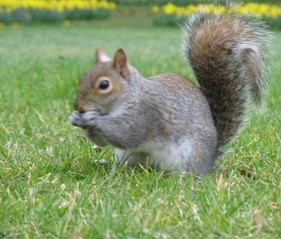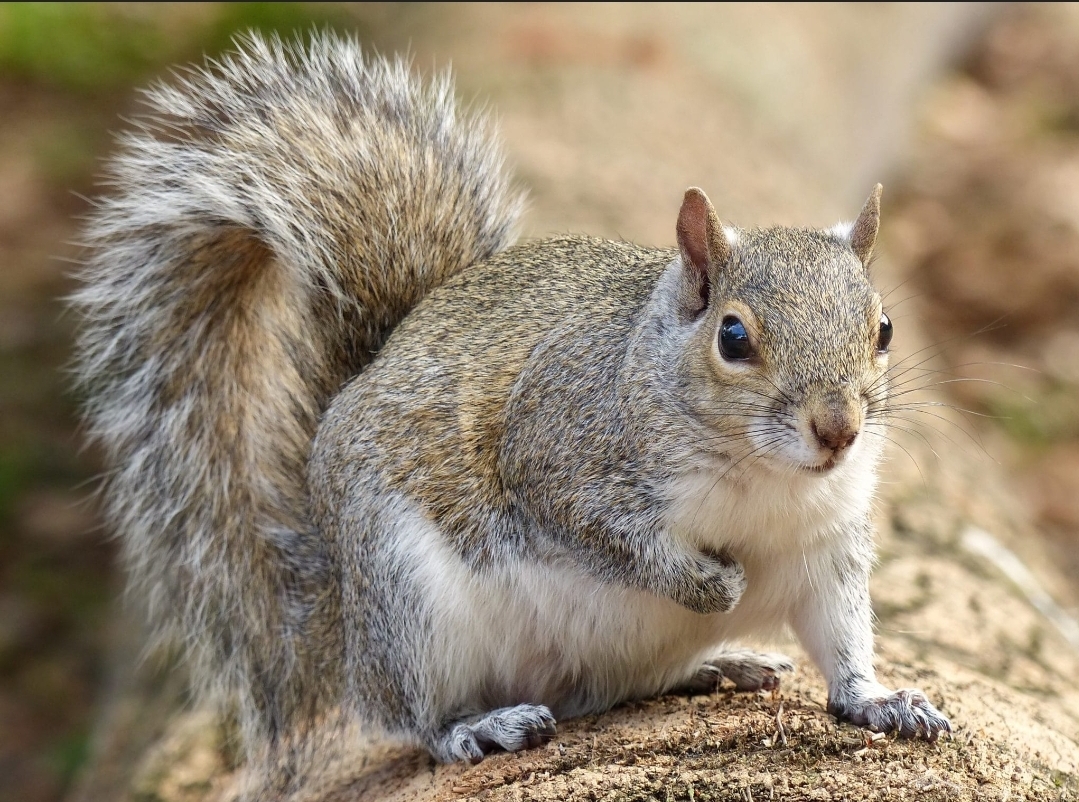Scientific Name: Sciurus carlinensis (Gray squirrel)
The eastern gray squirrel (sciurus carlinesnsis) is a member of the genus sciurus family. The eastern gray squirrel has predominantly gray fur, but it can have a brownish color. It has a white underside and a large bushy tail. The head and body length is from 23 to 30 cm, the tail from 19 to 25 cm and the adult weight varies between 400 and 600 grams. The eastern gray squirrel is commonly mistaken for the fox squirrel as the tracks of an eastern gray squirrel are difficult to distinguish from the fox squirrel, though the latter’s range is almost entirely different from the gray’s.
Both species are found throughout Florida. The eastern gray squirrel is found in dense woodland areas and forests.
Eastern gray squirrels eat a range of foods, that includes tree bark, berries, seeds, acorns, walnuts and other nuts. They also eat some types of fungi found in the forests, including fly agaric mushrooms. The diet of the fox squirrel consists of plant material such as nuts, seeds, fungi, fruit and buds. They have also been known to occasionally eat animal material such as insects and bird eggs.
The eastern gray squirrel is a scatter hoarder; by hoarding food in numerous small caches. Some caches are temporary, especially those made near the site of a sudden abundance of food which can be retrieved within hours or days for reburial in a more secure site. Others are more permanent and are not retrieved until months later. Each squirrel is estimated to make several thousand caches each season. The squirrels have accurate memories for the locations of these caches and use distant and nearby landmarks to retrieve them. They also use smell to detect the cache once they are a few inches away. Squirrels have been known to pretend to bury food when they feel they are being watched. They do this by preparing the spot as usual, for instance digging a hole or widening a crack, miming the placement of the food, while actually concealing it in their mouths, and then covering up the cache as if they had placed the food there. The eastern gray squirrel breeds twice a year which usually occurs in December to February and May to June. There are far less fox squirrels than gray squirrels but can sometimes be seen searching for food in pastures or openings nearby forests. They spend more time on the ground than in trees and often attempt to escape enemies by running rather than climbing. Both the eastern gray and the fox squirrel build a type of nest, called a drey, in the forks of trees, consisting mainly of dry leaves and twigs.
The eastern gray squirrel carry several parasites such as lice, mites, protozoa, fleas, acanthocephala, mematoda and cestoda. The one disease that squirrels are known to be carriers of that affect humans is a form of typhus. Squirrels are not associated with rabies or any other disease that can affect humans.
They may also nest in attics or exterior walls of a house, where they could cause fire hazards from their habit of gnawing on the electrical wiring.
Eastern gray squirrels are more active during the early and late hours of the day, and tend to avoid the heat in the middle of a summer day. They do not hibernate. The eastern gray squirrel is one of very few species that can descend a tree head-first.

